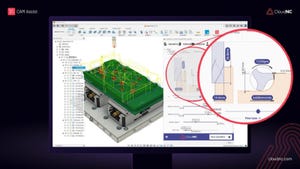Stratasys Delivers First HP-Branded 3-D Printers
April 20, 2010
The Hewlett-Packard era of rapid prototypingofficially begins this week.
Additive fabrication system manufacturer Stratasys Inc.announced it has delivered its first shipments of HP-branded 3-D printers. Underan agreementannounced earlier this year, Stratasys will manufacture 3-D printing systemsthat are co-developed with HP, which will initially market the systems inEurope. The agreement is expected to eventually span the globe, creating a hugenew market for rapid prototyping.
The products are called Designjet 3-D printers.
"The agreement to develop and manufacture a product toHP's specification is a milestone for us," says Stratasys CEO Scott Crump."Today, we're taking a big step in realizing the agreement's potential bydemonstrating we can deliver."
Stratasys, which is based in Eden Prairie, MN, is thelargest producer of 3-D printers in the world, with a market share of more than50 percent.
"There are millions of 3-D designers using 2-D printerswho are ready to bring their designs to life in 3D," says Santiago Morera, HP'svice president and general manager of its Large Format Printing Business."Stratasys FDM technology is the ideal platform for HP to enter the 3-D MCADprinting market and begin to capitalize on this untapped opportunity."
Product designers, engineers and architects who designwith CAD use 3-D printers as peripheral devices to "print" or producea tangible 3-D model from plastic or other material to verify the form, fit andfunction of designs prior to committing them to production or construction.
Stratasys, which manufactures 3-D printers under theDimension brand, uses ABS plastic with a technology called Fused DepositionModeling (FDM). The patented process creates parts by extruding semi-moltenplastic in thin layers to build the part, layer by layer. The process ofproducing a part layer by layer is known generically as "additive fabrication"or "additive manufacturing."
The term "3-D printer" was coined by Stratasys when itintroduced its first compact system co-developed with IBM in the mid-1990s.
Recent advances in 3D printers have dramatically reducedtheir cost and improved ease-of-use and reliability. Stratasys introduced itsDimension 3-D printer line in 2002, with the first printer priced under$30,000. Early last year, Dimension broke the $15,000 barrier with itsoffice-friendly uPrint,which fits on a desktop. The HP versions are cousins of the uPrint line.
Stratasys made thedistribution agreement with HP's Graphic Solutions Business, which is part ofthe company's $24 billion Imaging and Printing Group.
Stratasys Delivers First HP-Branded 3-D Printers_A
About the Author(s)
You May Also Like



.jpg?width=300&auto=webp&quality=80&disable=upscale)

